by Rod
Elser and Jane Carroll
(click on photos to enlarge image)
SILVER OPEN SALTS AT THE VICTORIA & ALBERT MUSEUM
(part 1)
The Victoria and Albert Museum -or just the "V&A" as it is
more commonly known- is located on Cromwell Road in London and
was established in 1852. It started as the Museum of
Manufactures but was soon renamed the South Kensington Museum.
Over the next few decades its collections expanded rapidly so
that by the end of the century a new building was designed and
built. Queen Victoria laid the cornerstone in 1899 and because
of the generous support she and Prince Albert had provided over
the years, the museum was renamed again and became the Victoria
and Albert Museum. It has continued to grow and it now houses
over 5 million objects spread over nearly 8 miles of galleries.
As we approached the side entrance to the museum we were visibly
reminded of what London suffered during the "Blitz" by a sign on
the wall noting the damage the building sustained during the
1940 bombings -as evidenced by the many fist-sized pock marks in
the walls- has been intentionally left unrepaired. Once inside
we were pleasantly surprised to note that their policy allowed
still photographs (without the use of tripod equipment); the
challenge then became to locate the open salts among the
millions of pieces and miles and miles of galleries. While I’m
certain we failed to find all that were on display, we did
sleuth out at least three dozen, mostly located in the "Silver
Collection" but others that were scattered among other
collections of objects from the 16th, 17th and 18th centuries. A
subsequent visit to the V&A web site found photos of other salts
that were not on display and with the kind permission of the
museum have been included here as well (these photos are noted
with © Victoria and Albert Museum, London).
Their collection of salts spanned a period of manufacture of
nearly 500 years—dating from the early 1500’s to a very
contemporary silver salt made in 1979. The earliest ones clearly
dated to a time when salt itself was held in much higher esteem
than it is today. While not dating from the medieval period when
your place at the table, whether "above or below the salt", was
indicative of your social status (I’m fairly certain my
ancestors at this point in time were either busy cleaning the
stables or out plowing the fields), these "standing salts" still
showed the symbolic importance of salt. Even the later ones from
the 19th century, however, when salt was no longer such a
treasured commodity, show a level of craftsmanship befitting the
historical significance of salt.
The descriptions noted are those provided by the museum with
only minor edits. Where dimensions were given they have been
noted here as well. For lack of a better methodology, the salts
have been organized by age. Obviously we are very appreciative
of the V&A’s policy on photography so we can share these open
salts with fellow collectors and we would certainly encourage
anyone visiting London to view these items in person as well as
the many other lovely items in the museum’s collections.
The Burghley Nef open salt
Nautilus shell with parcel-gilt silver mounts,
raised, chased, engraved and cast, and pearls;
1527-28; Paris, France; H 35.2 cm., W 20.3 cm.
Medieval manuscript illuminations from as early as
the 14th century show similar nefs acting as lavish
and public status symbols on the dining table, often
marking the place of the host or honored guest. Nefs
were particularly prized in France and Italy, where
noble and royal inventories from dating back to the
13th century list copious silver and gol d ships,
but their appeal was more widespread, reaching
Germany, Spain and the Low Co untries.
The Burghley nef would probably have been specially
commissioned, but it is clear from contemporary
depictions of goldsmiths’ shops that smaller, less
elaborate nefs were part of the medieval goldsmith’s
stock-in-trade.
© Victoria and Albert Museum, London
|
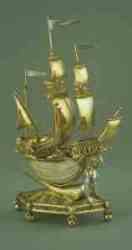 |
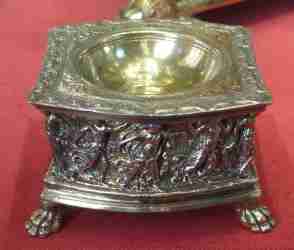 |
Silver-gilt salt
unmarked; Italy, c. 1530. H 5.00 cm., L 8.20 cm., W
8.00 cm.
This four-sided salt cellar is supported by lion’s
feet. The decoration of this exquisite salt cellar
is inspired by architectural and ornamental motifs
from the classical world, copying Greek and Roman
sculptural friezes with female figures dancing and
playing musical instruments.
|
Salt or spice-stand
silver-gilt, raised, chased, embossed, cast and
matted; about 1540; possibly Córdoba, Spain; H 7.00
cm., L 21.05 cm., W 21.05 cm.
This triangular vessel from Spain, similar in form
to small salt cellars, may have been used as a spice
dish. The decoration is inspired by motifs found on
classical antiques and architecture, such as the
scroll-shaped feet, the three supporting figures in
the shape of grotesque females and the reliefs
around the sides depicting cherubs fighting dragons.
The dragons have been based on images in bestiaries,
books about the behavior of animals, which were used
by Renaissance artists as sources for design.
© Victoria and Albert Museum, London
|
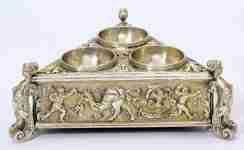
|
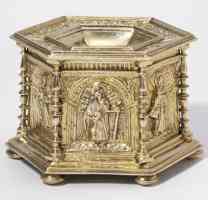 |
Ecclesiastical salt
silver gilt; 1550-1600; possibly Toledo or Cuenca,
Spain; H 9.00 cm., L 13.00 cm.
This hexagonal receptacle contained consecrated salt
for purifying holy water. Holy water is used for
ceremonies of consecration (such as Baptism), was
placed in water stoups at the entrance of a church
or in private homes, and was also used for healing
the sick. Inside this Spanish example are six niches
with figures of the Apostles with their attributes.
© Victoria and Albert Museum, London
|
Silver-gilt salt
engraved; c. 1575; Memmingen, Germany; H 2.50 cm., L
9.20 cm.
Small triangular salt cellars mounted on three feet
were common pieces of tableware in affluent homes in
late 16th-century Germany. The cities of southern
Germany dominated the goldsmiths’ craft there from
the 15th to the early 19th centuries. Their
goldsmiths and merchants travelled widely, the
former sometimes settling in cities that promised
new sources of patronage, the latter selling silver
goods as far north as the Baltic Sea and as far east
as Russia.
© Victoria and Albert Museum, London
|
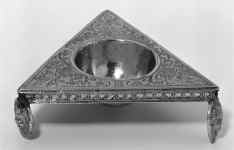
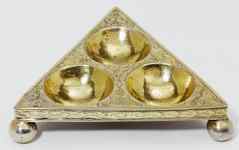
|
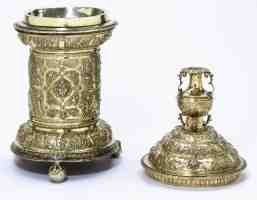 |
The Mostyn Salt
silver gilt, embossed, chased, punched and engraved;
1586-1587 (hallmarked); London, England; H 41.5 cm.,
W 19.1 cm. (including feet), D 7 ¼ in.
This type of salt cellar is known as a 'standing
salt'. From the late medieval period a large
ceremonial covered salt, or 'great' salt, was placed
on the high table at the host's side. This
distinguished the status of the diners, who sat
either 'above' or 'below' the salt. Smaller salts
were arranged around the tables, next to the
trenchers, or plates. These are known as 'trencher'
salts. Great salts were common by the mid 16th
century, but were still an important part of
household silver, valued as high status objects,
exchanged as New Year's gifts and passed on as
heirlooms. The ceremonial function of great salts
ensured that they were ornamented in the very latest
fashions. This example is decorated with motifs
characteristic of the late Renaissance, such as
strapwork, masks, flowers and fruit.
© Victoria and Albert Museum, London
|
The Vyvyan Salt
silver gilt, with painted and gilded glass (verre
églomisé); 1592-93 (hallmarked); London, England;
cover: H 23.0 cm.; standing salt: H 9 in., W 6 ¼
in., D 6 ½ in.; Weight 3.9 lbs.
This 'salt' is a large, ceremonial object which
would have been placed in front of the head of the
household or the guest of honor as a container for
salt during a meal. The glass panels are made of
verre eglomisé which is a process in which the image
is painted on the reverse of the glass and backed
with silver or gold foil to make it reflective. The
panels are painted with images from emblem books
such as Geoffrey Whitney's A Choice of Emblemes
(1586) and Paradin's Devises héroïques. The designs
shown on this salt include a fruiting vine around a
tree, a snake in a strawberry plant and red roses
with bees and spiders. Each picture was symbolic:
for example, the image of the snake and the
strawberry plant warned against flattery and sugared
words. The glass panels are also decorated with
portrait heads of Alexander the Great, Julius
Caesar, Ninus and Cyrus. A figure of Justice acts as
the finial. This salt has been passed down through
the Vyvyan family of Trelowarren House, Cornwall
since the early 17th century.
© Victoria and Albert Museum, London
|
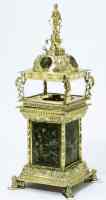 |
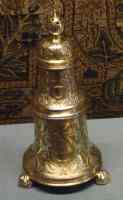 |
Silver gilt salt
chased and engraved; hallmarked for 1594-1595; made
in London by an unidentified maker with the mark
‘NR’.
|
Silver-gilt salt set with enamelled bosses
1600-1625; Spain; H 22.07 cm., L 10 cm.
This salt cellar can be detached into three parts,
each standing on shell-shaped feet. The containers
were used for salt or sugar and the top part was a
sprinkler for spices. This piece suggests a reaction
in early 17th century Spain against the severity of
the Herreran style, influential in Spanish
goldsmiths' work in the later 16th century. Although
the pilaster ornament is a remnant of the earlier
style, the surfaces are now covered with engraved
scrolls and colorful enamel medallions with ornate
patterns
© Victoria and Albert Museum, London
|
 |
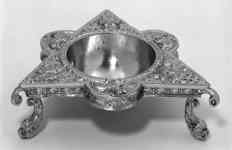 |
Silver-gilt salt
c. 1600; Germany; H 9.50 cm., L 2.30 cm.
Small triangular salt cellars mounted on three feet were common pieces of tableware in affluent
homes in late 16th-century Germany. The cities of Nuremberg and Augsburg dominated the goldsmiths’
craft in Germany from the 15th to the early 19th centuries. Engraved designs for silver flowed off
their printing presses into workshops across Europe
© Victoria and Albert Museum, London
|
Standing salt
silver, parcel-gilt, chased and engraved; 1624;
possibly Fransoys Eeioet or Frederick Elioet;
Utrecht (city), Netherlands; H 14.00 cm., L 14.00
cm., W 14.00 cm.
Ceremonial standing salt cellars were important
pieces of dining silver throughout northern Europe
from the 15th to the 17th centuries, a reflection of
the precious status of salt. This example is
decorated with bells, a gilt military figure and
engraved ornament. The three holes on the upper
surface suggest that some further decorative
features have been lost.
© Victoria and Albert Museum, London
|
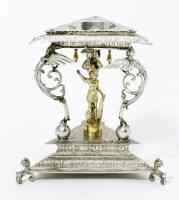 |
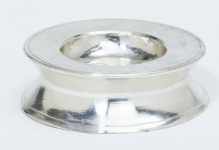 |
The Stoke Prior Trencher Salt
silver, engraved; 1639-1640 (hallmarked); London,
England; H 1.8 cm., D 6.3 cm. at foot.
The inconvenience of a central standing salt
encouraged the development in the mid-16th century
of sets of small plain trencher salts without covers
for daily use. They were made in plain, lightweight
silver such as this one but also in pewter or
ceramic. Trencher salts took their name from the
large piece of coarse bread or the wooden platter
from which diners ate. This salt and several other
pieces of domestic silver were found in 1891 by a
boy chasing rabbits at Stoke Prior, near Leominster.
It is a particularly interesting group as this sort
of relatively simple household silver rarely
survives
© Victoria and Albert Museum, London
|
The Moody Standing Salt or ceremonial salt
cellar
silver with repousse´ work and chasing; hallmarked
for 1664-1665; probably made in London by Wolfgang
Howzer for a member of the Moody family whose
initials are pricked on the salt. H. 18.8 cm., W. 19
cm.
Decorative holders for salt were popular as gifts at
marriage and christenings for either the couple or
the child. This form of salt without a cover but
with scrolled branches was popular from about 1660.
It was the last common form of ceremonial salt made
before the salt evolved into a centerpiece around
1700. The scroll arms are designed either to hold an
embroidered cloth cover or napkin or to bear a
dessert dish. They show the transition from salt to
centerpiece that took place in the 17th century and
the related new emphasis on the dessert course.
|
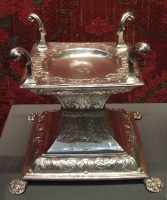 |
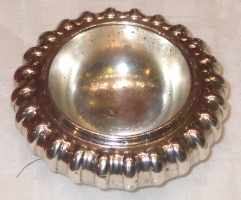 |
"Kemp Salt"
silver, unmarked, c. 1690.
It is engraved with the crest of Kemp of Norfolk and
later the crest of Howard, Dukes of Norfolk.
|
Silver, parcel-gilt salt
1692; Amsterdam, Netherlands; H 6.00 cm., L 9.00
cm., W 9.00 cm.
Restrained designs for silver grew increasingly
popular throughout the second half of the 17th
century, possibly in reaction to the theatrical
grandeur of much Baroque silver. The combination of
controlled forms with pierced hearts and scrolls,
punched surfaces, bands of beading and cut-card work
(pierced sheets of silver applied to the surface)
was typical of goldsmiths' work around Amsterdam in
the late 17th and early 18th centuries. A fine layer
of gold has been applied to the bowl of this salt
cellar to prevent the salt reacting with the silver.
© Victoria and Albert Museum, London
|
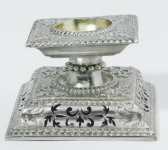 |
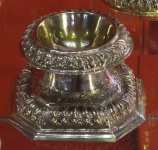 |
Silver salt with parcel-gilt
mark of Johann Ulrich Jebenz; Augsburg, Germany;
1708-10.
Salts like this were part of sets for use on the
dining table.
|
Silver salt cellar
(one of a pair) with gilt interior and applied,
cutcard acanthus leaves, engraved with the crest of
Sebright; mark of Louis Cuny; London, 1728-9.
The first London-made version of this pattern,
derived from a French model that appeared in around
1712. It remained popular until the 1750s. The
gilding prevented the salt from corroding the bowl.
|
 |
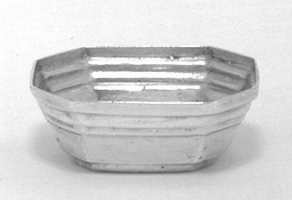 |
Miniature silver salt
c. 1730; made by David Clayton, London, England; H
1.03 cm., L 2.8 cm., W 2.41 cm., weight 3.2 grams.
This miniature salt or salt cellar is a toy. The
term toy included any knick-knack or fashionable
trinket for adults, as well as a child’s plaything.
Silver toys like this one copied the exact details
and proportions of normal sized pieces and came in a
variety of subjects and sizes, ranging from domestic
utensils to elaborate furniture. There are several
explanations for them: they might have been intended
to furnish dolls’ houses, as miniature trade
samples, as practice pieces for apprentices, as
fashionable novelties for adults to collect or they
might simply have been playthings for rich children.
The high point of production in London was the
period 1700-1750. Because they were light and small,
silver toys are not fully hallmarked and often the
form of the maker’s or retailer’s mark helps to date
them.
© Victoria and Albert Museum, London
|
Silver salt cellars
left:(one of a set of four); mark of Edward Wood;
London, 1735-36.
right: (one of a set of four); engraved with an
unidentified crest; mark of Edward Wood; London,
1726-7.
|
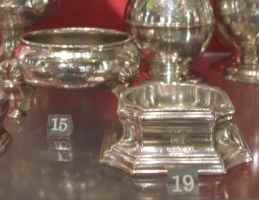 |
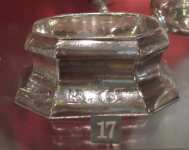 |
Silver salt cellar
(one of a pair); mark of David Hennell; London,
1740-41.
|
Silver-gilt salt
embossed; c. 1750; Moscow, Russia; D 11.60 cm., H
11.80 cm.
The maker of this hourglass-shaped salt cellar has
used a south German example as a model. It is
embossed with scrolls and foliage in the exuberant
Rococo style and is very light in weight. Moscow
goldsmiths had their own repertoire of traditional
Russian forms and techniques but from the early 18th
century, when Tsar Peter the Great established St
Petersburg as the Russian capital, they also adopted
the international styles of Western Europe
© Victoria and Albert Museum, London
|
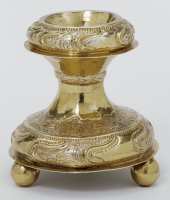 |
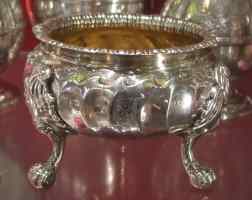 |
Silver salt cellar with gilt interior
engraved around 1765 with the royal crest and later
of Bridge mark of Thomas Heming, London, 1762-3.
Thomas Heming was the Royal Goldsmith from 1760 to
1783. The Prince Regent gave this, with other
silver, to an ancestor of the Browne family around
1815.
|
Silver salts with blue glass liners
(pair); engraved with unidentified crest; mark of
David and Robert Hennell I; London, 1770-1.
The Hennell family was a family of successful
silversmiths founded by David Hennell I who entered
his first mark at Goldsmiths’ Hall in 1736 and
remained in business until his death in 1811. He
specialized in salts and supplied retailers such as
George Wickes. Robert Hennell I registered a joint
mark with his father in 1763 but worked under his
own mark from 1772. The firm still exists today in
Bond Street.
|
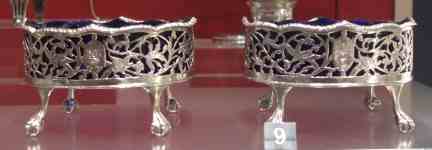 |
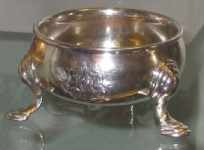 |
Silvered brass salt cellar
unidentified makers mark ‘IB’ and false marks,
England, about 1770.
Copper alloys can taint food and drink, so
protective silvering and tinning were common.
Silvered brass offered a cheaper alternative to
silver. The silvering of this piece has been renewed
but it still must have been quite convincing when it
was first done. The false marks on the base imitated
standard silver hallmarks and were obviously
intended to fool the casual purchaser.
|
|
|
Rod Elser and Jane Carroll
Rod is Editor of the National Newsletter of the Open
Salt Collectors, an organization based in the United
States.
His wife Jane, a native of England, is ever patient with
his "obsession" (her words) with open salts.
- 2009 -
Information about Open Salt Collectors is available at their web site: www.opensalts.info
|
|
|
 ASSOCIATION OF SMALL COLLECTORS OF ANTIQUE SILVER
ASSOCIATION OF SMALL COLLECTORS OF ANTIQUE SILVER























